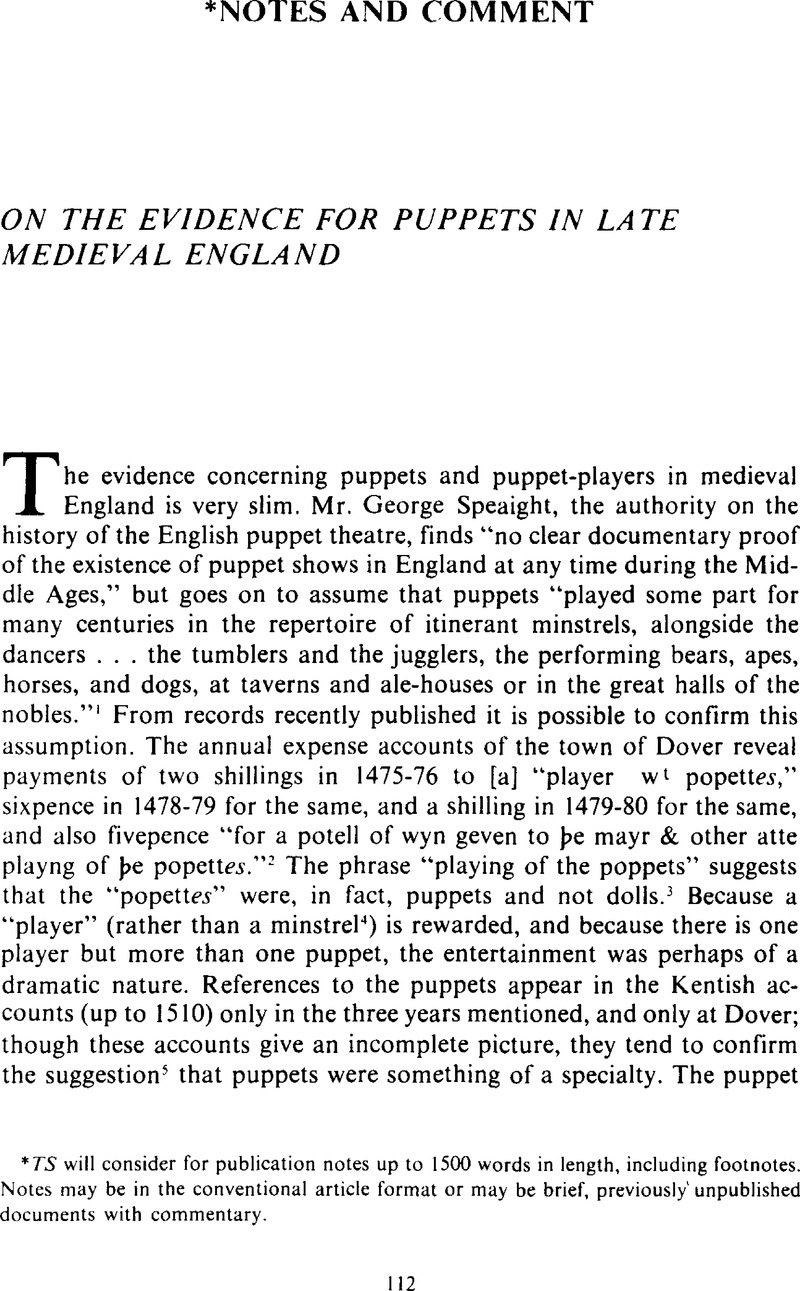No CrossRef data available.
Published online by Cambridge University Press: 07 July 2009

* TS will consider for publication notes up to 1500 words in length, including footnotes. Notes may be in the conventional article format or may be brief, previously unpublished documents with commentary.
1 Speaight, George, The History of the English Puppet Theatre (London, 1955), pp. 52–53Google Scholar.
2 [Dawson, Giles]. Records of Plays and Players in Kent 1450–1642 (The Malone Society Collections VII, 1965), pp. 26–27Google Scholar. Dr. Dawson takes no account of these entries in the section of his introduction on “kinds of entertainers.”
3 The earliest entry in the O.E.D. for “puppet” in the theatrical sense is dated 1538. (This is also Mr. Speaight's first clear piece of evidence.) The earliest entry for “poppet” in the sense of “puppet” is dated 1586; the Kentish records antedate this by a hundred and some years. For a 1568 usage, see Malone Society Collections II (1931), p. 302.
4 See Dawson, pp. xi-xii.
5 Speaight, p. 53.
6 Lambarde, William, An Alphabetical Description of the Chief Places in England and Wales (London, 1730), pp. 459–460Google Scholar; Chambers, E. K., The Mediaeval Stage (Oxford, 1903), II, 158Google Scholar.
7 Speaight, p. 53.
8 In an unpublished paper entitled “Puppetry in Medieval English Drama,” delivered at the 1971 annual convention of the Modern Language Association of America, held in Chicago.
9 It is fair to assume that dolls, as distinct from puppets, were used in some productions, especially in Nativity plays; they may sometimes have been jointed: see Anderson, M. D., Drama and Imagery in English Medieval Churches (Cambridge, 1963), pp. 133–134Google Scholar. Representations of animals were also sometimes used.
10 Speaight, p. 54.
11 Furnivall, F. J., ed. The Digby Mysteries (E.E.T.S., E. S., 70, 1896), pp. xxii, xxivGoogle Scholar. Furnivall does not understand the phrase, and adds a note: “This is the only way that Mr. C. T. Martin of the Record Office and I can read the MS.”
12 O.E.D., “God,” II, 5, e; M.E.D., “God,” l(b).
13 O.E.D., “String,” sb, I, 1, a and f.
14 Deimling, H. and DrMatthews, , eds. The Chester Plays (E.E.T.S., E.S., 62, 115, 1893–1916), p. 279Google Scholar. —See also England, G. and Pollard, A. W., eds. The Towneley Plays (E.E.T.S., E.S., 71, 1897), pp. 226, 228 (“Do Io furth, Io! and trott on a pase!”)Google Scholar.
15 Block, K., ed. Ludus Coventriae (E.E.T.S., E.S., 120, 1922), p. 280Google Scholar. For Christ's suffering before the actual crucifixion as a typical late medieval subject, see Mâle, É., L'Art Religieux de la Fin du Moyen Age en France, 4th ed. (Paris, 1931), pp. 85–98Google Scholar.
16 Stokes, Whitely, ed. Gwreans and Bys (Berlin, 1864), p. 28Google Scholar; Speaight, p. 54.
17 For devils in general and devils' costumes, about which there is little direct evidence, see Anderson, pp. 169–177. The title of Miss Anderson's seventh chapter, “A Puppet-show of the lost Norwich Plays,” is unfortunate.
18 Stokes, p. 28; see also lines 351–54, 438, 475–79.
19 The “cotte of lether for Christ” required at Chelmsford (Chambers, II, 346), and the “whit leder” for Christ at Coventry (Craig, H., ed. Two Coventry Corpus Christi Plays, 2nd ed. [E.E.T.S., E.S., 87, 1957], pp. 85–86) suggest a white costume with red drops on it, for the scourgingGoogle Scholar.
20 The Towneley Plays, p. 5. “Tatyrd as a foyll” = “dressed in clothing fantastically cut, like a fool” (see M.E.D., “fol,” noun, 3).
21 Chambers, II, 346.
22 O.E.D., “Of,” prep., VI, 18—“goblets garnished of silver”; “making red his sword of the blood of the … king” (c. 1477).
23 O.E.D., “Spirit,” sb., I, 2, b.
24 Anderson, p. 129; Evans, J., ed. The Flowering of the Middle Ages (London, 1966), p. 228Google Scholar; Caiger-Smith, A., English Medieval Mural Paintings (Oxford, 1963), pp. 6, 36Google Scholar; Rickert, M., Painting in Britain: The Middle Ages, 2nd ed. (Harmondsworth, 1965), pi. 193Google Scholar.
25 See The Towneley Plays, pp. 5–6 (with stage-direction, “Tunc exibunt demones clamando”); The Chester Plays, pp. 17–20 (with stage-direction, “Tunc [demones] quatiunt ettremescunt”); Smith, L. T., ed. York Plays (Oxford, 1885), pp. 4–5Google Scholar; Ludus Coventriae, p. 19 (a brief jocular version). There is no fall-of-Lucifer scene in the Cornish Ordinalia, which provided some material for the Cornish Creation; however, someone evidently saw the chance to introduce something of the stock scene into a production of this earlier play, and at the appropriate place added a stage-direction, “hic ludit Lucifer de celo” (Norris, E., ed., The Ancient Cornish Drama [Oxford, 1859], I, 5)Google Scholar.
26 For example, the Chester play of the fall of Lucifer has distinct overtones of the Last Judgment, including the reproachful speech of God (from the Improperia—see Brown, C., ed., Religious Lyrics of the XVth Century [Oxford, 1939], No. 105 and note)Google Scholar; compare The Chester Plays, pp. 9 and 427, 17 and 441. Later in the Cornish Creation, the devils also carry Lamech and Cain to hell “with great noise.”
27 O.E.D., “Cord,” sb 1., 1, b; M.E.D., “corde,” noun, la (a). See Caiger-Smith, p. 37, for devils hanging their prisoners. For “on” in the sense of “with,”see O.E.D., “On,” prep., III, 25.
28 See, for example, Morris, R., ed., The Pricke of Conscience (Berlin, 1863), pp. 185–186Google Scholar, 189–190. See ibid., p. 64, for the devils' becoming ugly after they fall.
29 Aebischer, P., ed., Le Mystère d'Adam (Geneva, 1964), p. 70Google Scholar. Translation from Adam, trans. Muir, L. R. (Leeds, 1970), p. 183Google Scholar.